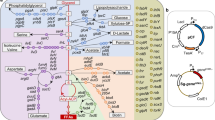Abstract
Systematic and combinatorial genetic approaches for the identification of gene knockout and overexpression targets have been effectively employed in the improvement of cellular phenotypes. Previously, we demonstrated how two of these tools, metabolic modeling and transposon mutagenesis, can be combined to identify strains of interest spanning the metabolic landscape of recombinant lycopene production in Escherichia coli. However, it is unknown how to best select multiple-gene knockout targets. Hence, this study seeks to understand how the overall order of gene selection, or search trajectory, biases the exploration and topology of the metabolic landscape. In particular, transposon mutagenesis and selection were employed in the background of eight different knockout genotypes. Collectively, 800,000 mutants were analyzed in hopes of exhaustively identifying all advantageous gene knockout targets. Several interesting observations, including clusters of gene functions, recurrence, and divergent genotypes, demonstrate the complexity of mapping only one genotype to one phenotype. One particularly interesting mutant, the ΔhnrΔyliE genotype, exhibited a drastically improved lycopene production capacity in basic minimal medium in comparison to the best strains identified in previous studies.




Similar content being viewed by others


References
Alper H, Stephanopoulos G (2007) Global transcription machinery engineering: A new approach for improving cellular phenotype. Metab Eng 9(3):258–267
Alper H, Fischer C, Nevoigt E, Stephanopoulos G (2005a) Tuning genetic control through promoter engineering. Proc Natl Acad Sci U S A 102(36):12678–12683
Alper H, Jin YS, Moxley JF, Stephanopoulos G (2005b) Identifying gene targets for the metabolic engineering of lycopene biosynthesis in Escherichia coli. Metab Eng 7(3):155–164
Alper H, Miyaoku K, Stephanopoulos G (2005c) Construction of lycopene-overproducing E. coli strains by combining systematic and combinatorial gene knockout targets. Nat Biotechnol 23(5):612–616
Alper H, Miyaoku K, Stephanopoulos G (2006a) Characterization of lycopene-overproducing E. coli strains in high cell density fermentations. Appl Microbiol Biotechnol 72(5):968–974
Alper H, Moxley J, Nevoigt E, Fink GR, Stephanopoulos G (2006b) Engineering yeast transcription machinery for improved ethanol tolerance and production. Science 314(5805):1565–1568
Badarinarayana VPWE III, Shendure J, Edwards J, Tavazoie S, Lam F, Church GM (2001) Selection analyses of insertional mutants using subgenic-resolution arrays. Nat Biotech 19(11):1060–1065
Becker-Hapak M, Troxtel E, Hoerter J, Eisenstark A (1997) RpoS dependent overexpression of carotenoids from Erwinia herbicola in OXYR-deficient Escherichia coli. Biochem Biophys Res Commun 239(1 SU):305–309
Cunningham FXSZ Jr, Chamovitz D, Hirschberg J, Gantt E (1994) Molecular structure and enzymatic function of lycopene cyclase from the Cyanobacterium Synechococcus sp strain PCC7942. Plant Cell 6(8):1107–1121
Hemmi H, Ohnuma S, Nagaoka K, Nishino T (1998) Identification of genes affecting lycopene formation in Escherichia coli transformed with carotenoid biosynthetic genes: candidates for early genes in isoprenoid biosynthesis. J Biochem (Tokyo) 123(6):1088–1096
Jordan SW, Cronan JE Jr (2003) The Escherichia coli lipB gene encodes lipoyl (octanoyl)-acyl carrier protein:protein transferase. J Bacteriol 185(5):1582–1589
Kang MJ, Lee YM, Yoon SH, Kim JH, Ock SW, Jung KH, Shin YC, Keasling JD, Kim SW (2005) Identification of genes affecting lycopene accumulation in Escherichia coli using a shot-gun method. Biotechnol Bioeng 91(5):636–642
Kim S-W, Keasling JD (2001) Metabolic engineering of the nonmevalonate isopentenyl diphosphate synthesis pathway in Escherichia coli enhances lycopene production. Biotechnol Bioeng 72(4):408–415
Leinfelder W, Forchhammer K, Zinoni F, Sawers G, Mandrand-Berthelot MA, Bock A (1988) Escherichia coli genes whose products are involved in selenium metabolism. J Bacteriol 170(2):540–546
Liu Y-G, Whittier RF (1995) Thermal asymmetric interlaced PCR: automatable amplification and sequencing of insert end fragments from PI and YAC clones for chromosome walking. Genomics 25(3):674–681
Maniatis T, Fritsch EF, Sambrook J (1982) Molecular cloning: a laboratory manual. Cold Spring Harbor Laboratory Press, Cold Spring Harbor
Miller JH (1992) A short course in bacterial genetics. Cold Springs Harbor Laboratory Press, Cold Springs Harbor
Reed J, Vo T, Schilling C, Palsson B (2003) An expanded genome-scale model of Escherichia coli K-12 (iJR904 GSM/GPR). Genome Biol 4(9):R54
Shannon P, Markiel A, Ozier O, Baliga NS, Wang JT, Ramage D, Amin N, Schwikowski B, Ideker T (2003) Cytoscape: a software environment for integrated models of biomolecular interaction networks. Genome Res 13(11):2498–2504
Stemmer WP (1994) Rapid evolution of a protein in vitro by DNA shuffling. Nature 370(6488):389–391
Vadali RV, Fu Y, Bennett GN, San KY (2005) Enhanced lycopene productivity by manipulation of carbon flow to isopentenyl diphosphate in Escherichia coli. Biotechnol Prog 21(5):1558–1561
Yuan LZ, Rouviere PE, LaRossa RA, Suh W (2006) Chromosomal promoter replacement of the isoprenoid pathway for enhancing carotenoid production in E. coli. Metab Eng 8(1):79–90
Zinoni F, Birkmann A, Stadtman TC, Bock A (1986) Nucleotide sequence and expression of the selenocysteine-containing polypeptide of formate dehydrogenase (formate–hydrogen–lyase-linked) from Escherichia coli. Proc Natl Acad Sci U S A 83(13):4650–4654
Acknowledgements
We acknowledge financial support by the DuPont-MIT Alliance.
Author information
Authors and Affiliations
Corresponding author
Rights and permissions
About this article
Cite this article
Alper, H., Stephanopoulos, G. Uncovering the gene knockout landscape for improved lycopene production in E. coli . Appl Microbiol Biotechnol 78, 801–810 (2008). https://doi.org/10.1007/s00253-008-1373-x
Received:
Revised:
Accepted:
Published:
Issue Date:
DOI: https://doi.org/10.1007/s00253-008-1373-x


